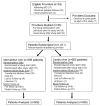Efficacy of a clinical decision-support system in an HIV practice: a randomized trial
- PMID: 23208165
- PMCID: PMC3829692
- DOI: 10.7326/0003-4819-157-11-201212040-00003
Efficacy of a clinical decision-support system in an HIV practice: a randomized trial
Abstract
Background: Data to support improved patient outcomes from clinical decision-support systems (CDSSs) are lacking in HIV care.
Objective: To test the efficacy of a CDSS in improving HIV outcomes in an outpatient clinic.
Design: Randomized, controlled trial. (ClinicalTrials.gov registration number: NCT00678600)
Setting: Massachusetts General Hospital HIV Clinic.
Participants: HIV care providers and their patients.
Intervention: Computer alerts were generated for virologic failure (HIV RNA level >400 copies/mL after a previous HIV RNA level ≤400 copies/mL), evidence of suboptimal follow-up, and 11 abnormal laboratory test results. Providers received interactive computer alerts, facilitating appointment rescheduling and repeated laboratory testing, for half of their patients and static alerts for the other half.
Measurements: The primary end point was change in CD4 cell count. Other end points included time to clinical event, 6-month suboptimal follow-up, and severe laboratory toxicity.
Results: Thirty-three HIV care providers followed 1011 patients with HIV. In the intervention group, the mean increase in CD4 cell count was greater (0.0053 vs. 0.0032 × 109 cells/L per month; difference, 0.0021 × 109 cells/L per month [95% CI, 0.0001 to 0.004]; P = 0.040) and the rate of 6-month suboptimal follow-up was lower (20.6 vs. 30.1 events per 100 patient-years; P = 0.022) than those in the control group. Median time to next scheduled appointment was shorter in the intervention group than in the control group after a suboptimal follow-up alert (1.71 vs. 3.48 months; P < 0.001) and after a toxicity alert (2.79 vs. >6 months; P = 0.072). More than 90% of providers supported adopting the CDSS as part of standard care.
Limitation: This was a 1-year informatics study conducted at a single hospital subspecialty clinic.
Conclusion: A CDSS using interactive provider alerts improved CD4 cell counts and clinic follow-up for patients with HIV. Wider implementation of such systems can provide important clinical benefits.
Primary funding source: National Institute of Allergy and Infectious Diseases.
Conflict of interest statement
Figures




Comment in
-
ACP Journal Club: a clinical decision-support system with interactive alerts improved CD4 cell count in HIV.Ann Intern Med. 2013 Apr 16;158(8):JC11. doi: 10.7326/0003-4819-158-8-201304160-02011. Ann Intern Med. 2013. PMID: 23588764 No abstract available.
References
Publication types
MeSH terms
Substances
Associated data
Grants and funding
- K24AI062476/AI/NIAID NIH HHS/United States
- R37 AI042006/AI/NIAID NIH HHS/United States
- K24DK080140/DK/NIDDK NIH HHS/United States
- K01 AI062435/AI/NIAID NIH HHS/United States
- P30 AI042851/AI/NIAID NIH HHS/United States
- R01 AI042006/AI/NIAID NIH HHS/United States
- P30AI42851/AI/NIAID NIH HHS/United States
- R37AI42006/AI/NIAID NIH HHS/United States
- K01AI062435/AI/NIAID NIH HHS/United States
- K24 AI062476/AI/NIAID NIH HHS/United States
- K24 DK080140/DK/NIDDK NIH HHS/United States
- P30 AI060354/AI/NIAID NIH HHS/United States
LinkOut - more resources
Full Text Sources
Medical
Research Materials
